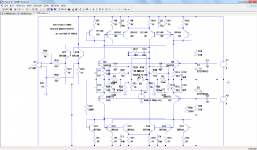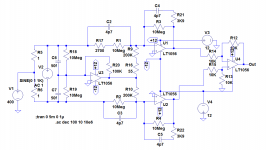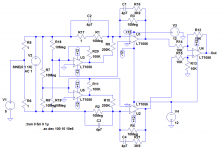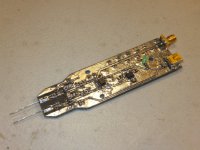Differential O-scope probes are still a lot of money, for some reason**, but I don't see why in a world of amazingly cheap, low-noise, precision op-amps it should be so difficult to create one - at least for audio use.
Has anyone built such a device for themselves? Are there any easy-bake recipes out there for such things? I've done a bit of search, and I may not be using the correct terms, as I get little of nothing.. but what could it require, other than possibly one or two hi-performance op-amps? I'd think that a very competent device could be built for around $25 USD - and that, with really fancy op-amps and a well-reg'd supply.
One requirement might be that it passes DC - so that might also be a hang up, but either way, even good to 10-100KHz should be fine for most all audio work.
(** might be a good one, which is why I ask, heh)
Has anyone built such a device for themselves? Are there any easy-bake recipes out there for such things? I've done a bit of search, and I may not be using the correct terms, as I get little of nothing.. but what could it require, other than possibly one or two hi-performance op-amps? I'd think that a very competent device could be built for around $25 USD - and that, with really fancy op-amps and a well-reg'd supply.
One requirement might be that it passes DC - so that might also be a hang up, but either way, even good to 10-100KHz should be fine for most all audio work.
(** might be a good one, which is why I ask, heh)
You can find the basics in the circuit I hatched for the QA400 http://www.diyaudio.com/forums/equipment-tools/231401-quantasylum-qa400-qa401.html#post3396418 . Essentially a differential amp and some resistors to scale for higher voltages. Jan's autoranger is similar for slightly different application: http://www.diyaudio.com/forums/equipment-tools/299635-autoranger-soundcards.html
You probably already know that most scopes can use 2 probes and channels to produce a differential signal. Connect both probe grounds together (and better still to the earth of the signal) and display channel 1 minus 2. Make sure that both vertical amps are set the same.
For low-freq work this usually works fine at least on the older tek/lecroy/hp scopes I've used.
For low-freq work this usually works fine at least on the older tek/lecroy/hp scopes I've used.
Howdy 1audio,
Thanks for the links, but neither point to anything like a schematic or parts list.. nor do I have any idea what a QA400 is or why I would be concerned with that.
Don't really want to dig though scores of pages to see what might be found. If you have a solution, could you just post it here? Thank you in advance..
Again, looking for a simple & straightforward (op-amp?) based differential oscilloscope probe. For those who might not know.. this is an +active+ probe, which uses electronic amplifiers vs. simple resistor dividers as seen in passive (1X / 10X probes).
You can find the basics in the circuit I hatched for the QA400 http://www.diyaudio.com/forums/equipment-tools/231401-quantasylum-qa400-qa401.html#post3396418 . Essentially a differential amp and some resistors to scale for higher voltages. Jan's autoranger is similar for slightly different application: http://www.diyaudio.com/forums/equipment-tools/299635-autoranger-soundcards.html
Thanks for the links, but neither point to anything like a schematic or parts list.. nor do I have any idea what a QA400 is or why I would be concerned with that.
Don't really want to dig though scores of pages to see what might be found. If you have a solution, could you just post it here? Thank you in advance..
Again, looking for a simple & straightforward (op-amp?) based differential oscilloscope probe. For those who might not know.. this is an +active+ probe, which uses electronic amplifiers vs. simple resistor dividers as seen in passive (1X / 10X probes).
You probably already know that most scopes can use 2 probes and channels to produce a differential signal.
You're right, I do know this..
And neither of my poor old scopes have this feature.. but that's beside the point, anyway. I'd like to build a quiet, precise differential voltage probe that will convert to a single-ended signal.
So.. like a pair of clips (in) to a BNC 50/75R coax output.
The schematic and a PC layout are attached to that first post. Its audio frequency (100 KHz) focused. The QA400 is an audio analyzer that did not have a differential input.
A real differential scope probe with 100 MHz bandwidth is difficult and challenging mechanically to make. What is the application (what are you probing) since that makes a big difference in the probe capabilities? One for 6000V will be very different from one to look at 10 mV in 10V.
A real differential scope probe with 100 MHz bandwidth is difficult and challenging mechanically to make. What is the application (what are you probing) since that makes a big difference in the probe capabilities? One for 6000V will be very different from one to look at 10 mV in 10V.
The schematic and a PC layout are attached to that first post. Its audio frequency (100 KHz) focused.
Great. 100KHz is plenty fine for our (audio) purposes. Now 10MHz would be +better+ but it's really not required, again, for most purposes in audio work. Heck, neither of my scopes have better than 10MHz bandwidth, IIRC (Telequipment D54 and D61). As I said "even good to 10-100KHz should be fine for most all audio work"
The QA400 is an audio analyzer that did not have a differential input.
Ah ok, thanks. I had no idea what device you were discussing / applying this to.
A real differential scope probe with 100 MHz bandwidth is difficult and challenging mechanically to make.
Yeah, no doubt! Well aware of this.. and I can't justify the cost of such an instrument. 100MHz is not a requirement!! 10% of that would be great, and 1% would be acceptable.
What is the application (what are you probing) since that makes a big difference in the probe capabilities? One for 6000V will be very different from one to look at 10 mV in 10V.
I'm using it for the same basic applications as yourself - Audio frequency range (5Hz to 50KHz or so) with possible DC offsets of several hundreds of volts. But I need a differential probe as I sometimes work with differential signals where grounding one side (one phase) is +not permissible+.
Again, just want an easy-bake recipe for an audio range (5-50Khz, or at least 20-20KHz) with good sensitivity down to ~10uV per unit. Roughly. A better scope would also be welcome, but I don't see any of those hanging on the trees..
Last edited:
recipe for an audio range (5-50Khz, or at least 20-20KHz) with good sensitivity down to ~10uV per unit.
See Fig. 1 here: A Deeper Look into Difference Amplifiers | Analog Devices
We've used a difference amplifier with an AD845 or similar, powered either by two 9V batteries,
or by a floating +/- 15V DC supply, using a power transformer with good isolation.
The input resistors (R1, R3) are each two 1M, 300V rated, resistors in series for each position.
The output resistors (R2, R4) are 20k each. This gives an attenuation of 1/100.
To trim the hf response, use a fixed 15pF across R4, and a variable 18pF capacitor across R2.
This circuit works down to DC. Use 3kV - 10kV rated test probe wire for the input leads, twisted.
Last edited:
I have built litterally dozens of them, because the requirements can be conflicting: do you just want to eliminate a mundane common mode signal, or do you want to measure the voltage across a low ohm shunt connected to the mains, do you need a moderate bandwidth, like 1MHz, or do you need the full 100MHz of your scope, etc.Differential O-scope probes are still a lot of money, for some reason**, but I don't see why in a world of amazingly cheap, low-noise, precision op-amps it should be so difficult to create one - at least for audio use.
Has anyone built such a device for themselves? Are there any easy-bake recipes out there for such things? I've done a bit of search, and I may not be using the correct terms, as I get little of nothing.. but what could it require, other than possibly one or two hi-performance op-amps? I'd think that a very competent device could be built for around $25 USD - and that, with really fancy op-amps and a well-reg'd supply.
One requirement might be that it passes DC - so that might also be a hang up, but either way, even good to 10-100KHz should be fine for most all audio work.
(** might be a good one, which is why I ask, heh)
I have access to Agilent/Keysight, Tek equipment, yet I brewed my own (and in vast numbers!).
Why? The commercially available probes do not fulfill the mix of real life situations: for DSL measurements, you need 25Vpp signal handling capability, 70V common mode and a minimum 30MHz bandwidth. The S/N ratio also needs to be good too, for QLN measurements.
Basically, not a single commercial probe fulfills all of the requirements.
For basic, low bandwidth applications, such an arrangement works well, and can be extended to ~5MHz without too much difficulty:
http://www.diyaudio.com/forums/equi...xpensive-probe-direct-mains-measurements.html
Note that oscilloscope differential measurements work (with limitations) provided you do not exceed the max common mode signal, which is barely higher than the full scale of the selected caliber, ie. useless for really challenging situations, like mains-referenced measurements
Elvee - your smart probe is great!
Currently i'm interested on a differential probe for the output of bridged class-d amps. At low output levels the common mode components may be much higher then the differential signal here. And some MHz bandwith to see the ripple or spikes from switching would be nice.
Do you have any suggestions or hints for this?
Currently i'm interested on a differential probe for the output of bridged class-d amps. At low output levels the common mode components may be much higher then the differential signal here. And some MHz bandwith to see the ripple or spikes from switching would be nice.
Do you have any suggestions or hints for this?
Why? The commercially available probes do not fulfill the mix of real life situations: for DSL measurements, you need 25Vpp signal handling capability, 70V common mode and a minimum 30MHz bandwidth. The S/N ratio also needs to be good too, for QLN measurements.
Basically, not a single commercial probe fulfills all of the requirements.
Those look like the specs for a Tek 7A13 7A13 - TekWiki long discontinued. Scope makers just don't see a need for this analog stuff today.
IndeedScope makers just don't see a need for this analog stuff today.
A probe that has a large common-mode handling capability, wide bandwidth, high differential sensitivity and low noise is the holy grail of differential measurements...Elvee - your smart probe is great!
Currently i'm interested on a differential probe for the output of bridged class-d amps. At low output levels the common mode components may be much higher then the differential signal here. And some MHz bandwith to see the ripple or spikes from switching would be nice.
Do you have any suggestions or hints for this?
It is feasible, but it is fiendishly complicated, unless you resort to advanced optical isolation techniques.
Here is a taste of such a beast (just the front-end): it measures millivolts of differential signal in the presence of kilovolt common mode, with a bandwidth of 25MHz.
I am certainly not going to attempt describing it....
In your case, you could reuse the principle of the smart probe, but with a more suitable ratio of 1:10, lower resistor values, a wide bandwidth opamp and a careful compensation scheme.
Another alternative is the following circuit: it is basically a differential amplifier, but equipped with a "common-mode killer", allowing to uncouple the common-mode signal handling capability from the differential gain: here, the differential gain is 1, yet the input accepts hundreds of volts (note that R16 and R17 are not actually needed, they are just there to study the effect of mismatches).
Of course, as there are no free lunches in engineering, the differential amp has its noise gain increased...
This is a somewhat more complex version of the same principle, it probably has some advantages over the previous one, but I don't remember which...
This has actually been built, with a TLE2074, and the bandwidth exceeds 4MHz.
With a better opamp and lower resistor values, a higher bandwidth should be attainable
Attachments
I saved some files from a Daniel Kramnick creation.
There's 30+files in the folder.
https://xellers.wordpress.com/electronics/1ghz-active-differential-probe/
There's 30+files in the folder.
https://xellers.wordpress.com/electronics/1ghz-active-differential-probe/
Attachments
Last edited:
are any of these a suitable substitute for the discontinued BF998 mosFET?
BF998 | NXP BF998 N-channel MOSFET Tetrode, 30 mA, 12 V Depletion, 4-Pin SC-61B | NXP
view "similar products" at the bottom of the page.
BF998 | NXP BF998 N-channel MOSFET Tetrode, 30 mA, 12 V Depletion, 4-Pin SC-61B | NXP
view "similar products" at the bottom of the page.
What they don't tell you is that the input impedances of the two inputs are widely different. May or may not be an issue, depending on the impedance of the point you want to measure.
Jan
> Differential O-scope probes
"Instrumentation amplifiers". Vast literature.
https://en.wikipedia.org/wiki/Instrumentation_amplifier
If you can live with +/-13V signals, or +/-100V with some added hiss, any jellybean chip opamps will do your 100KHz goals easy.
One thing: most IAs are amplifiers. Going into a 'scope, unity-gain is often ample. But some IAs have poorer CMRR at low gains.
As Jan says, some plans have impedance pitfalls.
"Instrumentation amplifiers". Vast literature.
https://en.wikipedia.org/wiki/Instrumentation_amplifier
If you can live with +/-13V signals, or +/-100V with some added hiss, any jellybean chip opamps will do your 100KHz goals easy.
One thing: most IAs are amplifiers. Going into a 'scope, unity-gain is often ample. But some IAs have poorer CMRR at low gains.
As Jan says, some plans have impedance pitfalls.
All good arguments for the three opamp instrumentation amp. THAT's ingenius stuff simiplfies all of this: THAT Corporation 1200-series InGenius High-CMRR Balanced Line Receiver ICs and should be more than adequate for these applications. No resistor trims even. Not for the DSL application however. . .
All good arguments for the three opamp instrumentation amp. THAT's ingenius stuff simiplfies all of this: THAT Corporation 1200-series InGenius High-CMRR Balanced Line Receiver ICs and should be more than adequate for these applications. No resistor trims even. Not for the DSL application however. . .
Good point, and good opamps!
- Status
- This old topic is closed. If you want to reopen this topic, contact a moderator using the "Report Post" button.
- Home
- Design & Build
- Equipment & Tools
- DIY Balanced / Differential oscilloscope probes?



